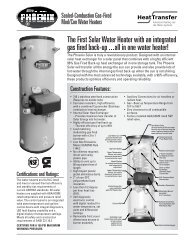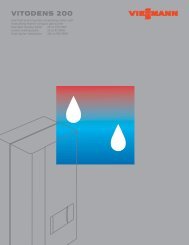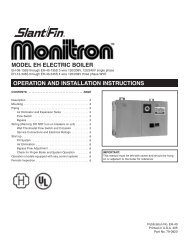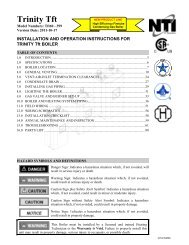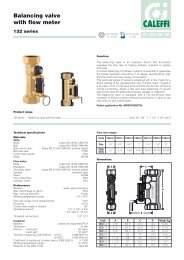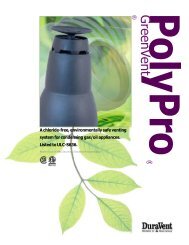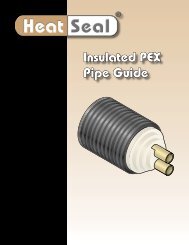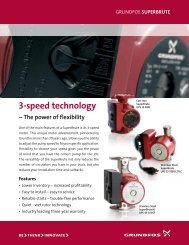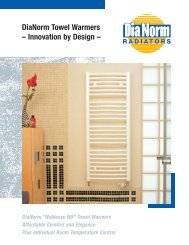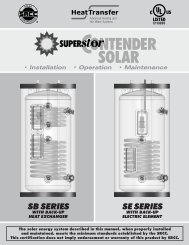Apricus Solar Water Heating System Installation and Operation ...
Apricus Solar Water Heating System Installation and Operation ...
Apricus Solar Water Heating System Installation and Operation ...
Create successful ePaper yourself
Turn your PDF publications into a flip-book with our unique Google optimized e-Paper software.
3.12.2. Brazed Plate Heat Exchangers<strong>Apricus</strong> <strong>Solar</strong> Collector <strong>Installation</strong> & <strong>Operation</strong> Manual - USAa) Advantages: Brazed plate heat exchangers (BPHE) are a compact <strong>and</strong> efficientheat transfer unit ideal for use in solar thermal systems. They are superior to coilheat exchangers because they allow the solar collector to run at a lower, moreefficient temperature, while transferring the same amount heat energy to the tank.b) Disadvantages: BPHE require an additional pump to facilitate circulation on thepotable (end-use) side of the plates. In areas with hard water, limescale can buildup restricting flow <strong>and</strong> requiring periodic flushing.c) Single vs Dual Wall: BPHE are available both in single wall <strong>and</strong> dual wallmodels. Dual wall models are required in some areas <strong>and</strong> generally need to havepositive leak detection, so fluid will leak out the sides if either of the plates rupture.When using a single wall heat exchanger the solar loop pressure should be lessthan the potable water pressure, according to local code.WARNINGSelecting the proper heat exchanger is important for the safety of the system. You mayonly use a single wall heat exchanger (internal or external) if the heat transfer fluid beingused is Generally Regarded As Safe. This information can be found in the Material DataSafety Sheet of the fluid.3.13. Wind Loadinga) Collector wind loading must be considered <strong>and</strong> the resulting stress on attachment points thoroughlyexamined. The attachment method may need the stamp of a professional engineer, depending on localregulation.b) The st<strong>and</strong>ard frame <strong>and</strong> frames kits are all designed to withst<strong>and</strong> wind speeds of up to 130 mph (208 km/h) without damage, which corresponds to the mid-range of Category 2 cyclones (US Saffir-Simpson scale).For higher wind speeds, reinforcement of the manifold <strong>and</strong> tube to frame attachment <strong>and</strong> frame to roofattachment is required <strong>and</strong> must be approved for use by <strong>Apricus</strong>, a licensed engineer <strong>and</strong> local authorities.c) Refer to Section 5 for specific roof attachment details for various frame options.d) Other mounting methods in high wind regions may require inspection <strong>and</strong> approval by a licensedengineer or the local building department. It is the responsibility of the installer to ensure that the framemounting is of suitable strength.e) In high wind regions, be advised of the following: Collectors installed on flat roofs with full front <strong>and</strong> rearexposure, can experience vertical pull forces up to 268.4 lbs (122 kg) in a 130 mph (208 km/h) wind on themiddle, rear round foot attachment point alone. The horizontal force pushing against the collector can reach396 lbs (180 kg) on the middle, front round foot. Both of these values are based on an install angle of 60°,with decreased uplift <strong>and</strong> horizontal force values at lower installation angles.The direction of load on the feet changes based on the angle. For example, at a 30° collector angle with arear wind, there is an uplift force on the middle, front foot of 49 lbs (22 kg). At a 45° collector angle, however,the same wind will actually create a downward force of 15 lbs (7 kg), because the collector is trying to tipforward. The table below provides peak vertical pull forces <strong>and</strong> horizontal (pushing) forces for an AP-30collector. These values represent both rear <strong>and</strong> frontal winds. The highest force of 396 lbs (180 kg) on themiddle, front foot at a 60° collector angle is actually from a frontal, <strong>and</strong> not rear, wind as it is trying to tip thecollector backward.Copyright 2011 – <strong>Apricus</strong> Inc Doc: A7-05.4.1.4-PB-1.9 Page 30 of 126



